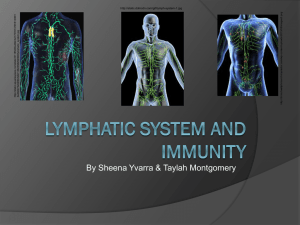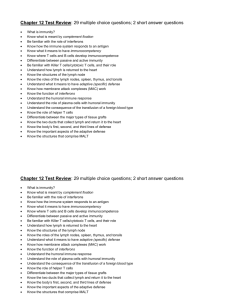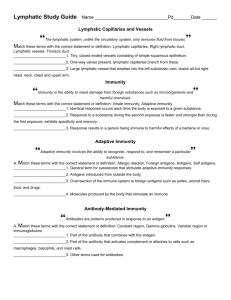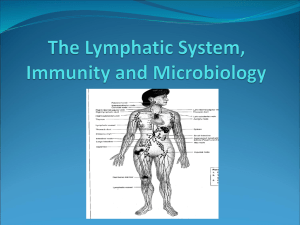Chapter 13 The Lymphatic System and Immunity
advertisement
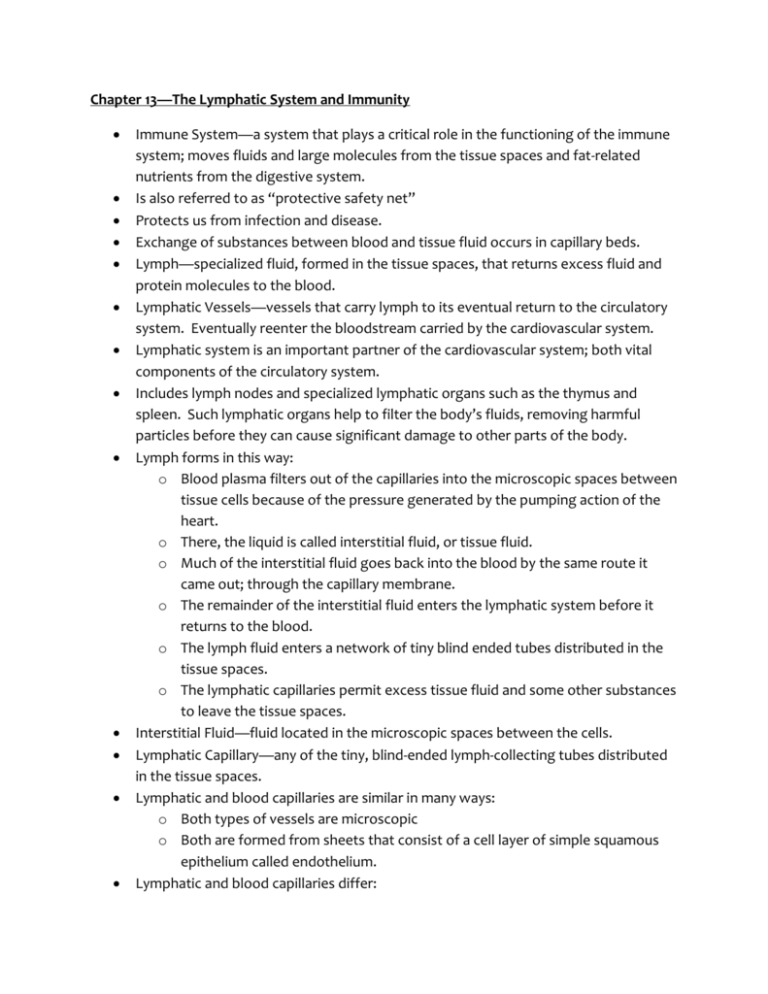
Chapter 13—The Lymphatic System and Immunity Immune System—a system that plays a critical role in the functioning of the immune system; moves fluids and large molecules from the tissue spaces and fat-related nutrients from the digestive system. Is also referred to as “protective safety net” Protects us from infection and disease. Exchange of substances between blood and tissue fluid occurs in capillary beds. Lymph—specialized fluid, formed in the tissue spaces, that returns excess fluid and protein molecules to the blood. Lymphatic Vessels—vessels that carry lymph to its eventual return to the circulatory system. Eventually reenter the bloodstream carried by the cardiovascular system. Lymphatic system is an important partner of the cardiovascular system; both vital components of the circulatory system. Includes lymph nodes and specialized lymphatic organs such as the thymus and spleen. Such lymphatic organs help to filter the body’s fluids, removing harmful particles before they can cause significant damage to other parts of the body. Lymph forms in this way: o Blood plasma filters out of the capillaries into the microscopic spaces between tissue cells because of the pressure generated by the pumping action of the heart. o There, the liquid is called interstitial fluid, or tissue fluid. o Much of the interstitial fluid goes back into the blood by the same route it came out; through the capillary membrane. o The remainder of the interstitial fluid enters the lymphatic system before it returns to the blood. o The lymph fluid enters a network of tiny blind ended tubes distributed in the tissue spaces. o The lymphatic capillaries permit excess tissue fluid and some other substances to leave the tissue spaces. Interstitial Fluid—fluid located in the microscopic spaces between the cells. Lymphatic Capillary—any of the tiny, blind-ended lymph-collecting tubes distributed in the tissue spaces. Lymphatic and blood capillaries are similar in many ways: o Both types of vessels are microscopic o Both are formed from sheets that consist of a cell layer of simple squamous epithelium called endothelium. Lymphatic and blood capillaries differ: o The flattened endothelial cells that form blood capillaries, however, fit tightly together so that large molecules cannot enter or exit from the vessel. o The “fit” between endothelial cells forming the lymphatic capillaries is not as tight. o The lymphatic capillaries are more porous and allow larger molecules, including proteins and other substances, as well as the fluid itself, to enter the vessel and eventually return to the general circulation. The movement of lymph in the lymphatic vessels goes one way only. Lymph does not flow over and over again through vessels that form a circular route. Have a “beaded” appearance, resulting from the presence of valves that assist in maintaining to one-way flow of lymph. The valves sometimes cause lymph to back up behind them and cause swellings that look like beads. Lymph flowing through the lymphatic capillaries next moves into successively larger and larger vessels sometimes called lymphatic venules and veins; eventually empting into one of two terminal vessels called the right lymphatic duct and the thoracic ducts, which empties their lymph into the blood in large veins in the neck region. Right lymphatic duct—short vessel into which lymphatic vessels from the right upper quadrant of the body empty lymph; the duct then empties the lymph into the circulatory system at the right subclavian vein. Thoracic duct—largest lymphatic vessel in the body. Lymph from 3/4‘s of the body eventually drains into the thoracic duct. Lymph from the right upper extremity and from the right side of the head, neck, and upper torso flows into the right lymphatic duct. Cisterna Chyli—an enlarged pouch on the thoracic duct that serves as a storage area for lymph moving toward its point of entry into the venous system. Serves as a temporary holding area for lymph moving toward its point of entry into the veins. Lacteals—a lymphatic vessel located in each villus of the intestine; serves to absorb fat materials from the chime passing through the small intestine. o They transport fats obtained from food to the bloodstream. Lymph node—performs biological filtration of lymph on its way to the circulatory system. o Lymph moves and is filtered by the lymph node. o Located in clusters along the pathway of lymphatic vessels. o May be small as a pinhead, others may be as large as a lima bean. o Most occur in groups or clusters in certain areas. o The structure of the lymph nodes makes it possible for them to perform two important functions: defense and white blood cell formation. o Are lymphoid organs because they contain lymphoid tissue, which is a mass of developing lymphocytes and related cells. o Lymphoid organs such as lymph nodes, tonsils, thymus, and spleen are important because they provide immune defense and development of immune cells. o Lymph nodes perform biological filtration, a process in which cells alter the contents of the filtered fluid. Biological filtration of bacteria and other abnormal cells by phagocytosis prevents local infections from spreading. Afferent Lymph vessel—any small lymphatic vessel that carries lymphatic fluid toward a lymph node. Lymph enters the node through four afferent lymph vessels; these vessels deliver lymph to the node. Once lymph enters the node, it “percolates” slowly through spaces called sinuses that surround nodules found in the outer (cortex) and inner medullary areas of the node. Lymph is filtered so that bacteria, cancer cells, and damaged tissue cells are removed and prevented from entering the blood and circulating all over the body. Lymph exits from the node through a single efferent lymphatic vessel. Efferent lymphatic vessel—any of the small lymphatic vessels that carry lymphatic fluid away from a lymph node. Clusters of lymph nodes allow a very effective biological filtration of lymph flowing from specific body areas. A surgeon uses knowledge of lymph node function when removing lymph nodes under the arms, axillary nodes, and nearby as well; these nodes may contain cancer cells filtered out of the lymph drained from the breast, for example. Cancer of the breast is one of the most common forms of this disease in women. Unfortunately, cancer cells from a single tumorous growth in the breast often spread to other areas of the body through the lymphatic system. Thymus gland—endocrine gland located in the mediastinum, vital part of the body’s immune system. o Composed of lymphocytes in mesh like framework. o Also called the thymus. o Is largest at puberty and even then weighs only about 35-40 grams—a little more than an ounce. o Plays central and critical role in the body’s vital immunity mechanism. o A source of lymphocytes before birth. o Especially important in the “maturation”, or development, of a type of lymphocyte that then leaves the thymus and circulates to the spleen, tonsils, lymph nodes, and other lymphoid tissues. Thymosin—hormone produced by the thymus that is vital to the development and functioning of the body’s immune system. The thymus appears to complete much of its work early in childhood, reaching its maximum size at puberty. The thymus tissue is then gradually replaced by fat and connective tissue, a process called involution. By age 60, the thymus is about half its maximum size and is virtually gone by age 80 or so. Masses of lymphoid tissue called tonsils are located in a protective ring under the mucous membranes in the mouth and back of the throat. o They help protect against bacteria that may invade tissues in the area around the openings between the nasal and oral cavities. Palatine tonsils—located on each side of the throat. Pharyngeal tonsils (adenoids)—tonsil located in the nasopharynx on its posterior wall; when enlarged, referred to as adenoids. Adenoids—literally, glandlike; adenoids, or pharyngeal tonsils, are paired lymphoid structures in the nasopharynx. Lingual tonsils—near the base of the tongue. The tonsils serve as the first line of defense from the exterior and as such are subject to chronic infection. They may need to be removed surgically if antibiotic therapy is not successful at treating the chronic infection or if swelling impairs breathing. The spleen is the largest lymphoid organ in the body. o It is located high in the upper left quadrant of the abdomen lateral to the stomach. o Protected by the lower ribs and it can be injured by abdominal trauma. o Has a very rich blood supply and may contain more than 500 mL, about a pint, of blood. o If damaged and bleeding, surgical removal, called a splenectomy, may be required to stop the loss of blood. o Blood flows through dense, pulp like accumulations of lymphocytes. As blood blows through the pulp, the spleen removes by filtration and phagocytosis many bacteria and other foreign substances, destroys worn out red blood cells and salvages the iron found in hemoglobin for future use, and serves as a reservoir for blood that can be returned to the cardiovascular system when needed. Allergy—used to describe hypersensitivity of the immune system to relatively harmless environmental antigens. Anaphylactic shock—shock resulting from a severe allergic reaction; may be fatal. Nonspecific immunity—maintained by mechanisms that attack any irritant or abnormal substance that threatens the internal environment; often called Innate Immunity. The skin and mucous membranes, for example, are nonspecific mechanical barriers that prevent entry into the body by bacteria and many other substances such as toxins and harmful chemicals. Tears and mucus also contribute to nonspecific immunity; tears wash harmful substances from the eyes, and mucus traps foreign material that may enter through the respiratory tract. Phagocytosis of bacteria by WBC’s is a nonspecific form of immunity. Inflammatory response—nonspecific immune process produced in response to injury and resulting in redness, pain, heat, and swelling and promoting movement of WBC’s to the affected area. Characteristics of inflammation: heat, redness, pain, and swelling—caused by increased blood flow, resulting in heat and redness, and vascular permeability, resulting in tissue swelling and the pain that it causes, in the affected region. Synonyms Specificity Speed of reaction Memory Chemicals Cells Nonspecific and Specific Immunity Nonspecific Immunity Specific Immunity Innate immunity, native Adaptive immunity, immunity, genetic acquired immunity. immunity. Not specific—recognizes Specific—recognizes variety of nonself or certain antigens on certain abnormal cells and cells or particles. particles. Rapid—immediate up to Slower—several hours to several hours. several days. None—same response to Yes—enhanced response repeated exposures to to repeated exposures to same antigen. same antigen. Complement proteins, Antibodies, various interferons, others. signaling chemicals. Phagocytes (neutrophils, Lymphocytes (B cells and T macrophages, dendritic cells). cells). Specific Immunity—the protective mechanisms that provide specific protection against certain types of bacteria or toxins. Specific immunity involves memory and the ability to recognize and respond to certain harmful substances or bacteria. Because it is able to adapt to newly encountered “enemies”, specific immunity is often called adaptive immunity. In specific immunity, when the body is first attacked by particular bacteria or viruses, disease symptoms may occur as the body fights to destroy the threatening organism. If body is exposed a second time to the same threatening organism, no serious symptoms occur because the organism is destroyed quickly, known as immunity. Immunity to one type of disease causing bacteria or virus doesn’t protect the body against others; immunity can be very selective. Specific immunity may be classified as either “natural” or “artificial” depending on how the body is exposed to the harmful agent. Artificial exposure is called immunization and is the deliberate exposure of the body to a potentially harmful agent. Natural and artificial immunity may be “active” or “passive”. Active immunity occurs when an individual’s own immune system responds to a harmful agent, regardless of whether that agent was naturally or artificially encountered. Passive immunity results when immunity to a disease that has developed in another individual or animal is transferred to an individual who was not previously immune. Active immunity generally lasts longer than passive immunity. Passive immunity, although temporary, provides immediate protection. Natural Immunity Active Immunity Passive Immunity Artificial Immunity Active Immunity Types of Specific Immunity Exposure to the causative agent is not deliberate, happens naturally in course of living. A child develops measles and acquires immunity to a subsequent infection. A fetus receives protection from the mother through the placenta, or an infant receives protection via the mother’s milk. Exposure to the causative agent is deliberate. Injection of the causative agent, such as a vaccination against polio, activates the immune system and thus confers immunity. Passive Immunity Injection of protective material, antibodies, that was developed by another individual’s immune system is given. The immune system functions because of adequate amounts of defensive protein molecules and protective cells. The protein molecules critical to immune system functioning are called antibodies and complement proteins. Antibodies—are protein compounds that are normally present in the body. o Uniquely shaped concave regions, called combining sites, on its surface. o Ability of an antibody molecule to combine with a specific compound called an antigen. o Antigens are often protein molecules embedded in the surface membranes of threatening or diseased cells, such as microorganisms or cancer cells. o Produces humoral, or antibody mediated, immunity by changing the antigens in a way that prevents them from harming the body. Antibody mediated immunity—immunity that is produced when antibodies make antigens unable to harm the body; also referred to as humoral. An antibody must first bind to its specific antigen, which forms an antigen-antibody complex. The antigen antibody complex then acts in one or more ways to make the antigen, or the cell on which it’s present, harmless. Agglutinate—antibodies causing antigens to clump or stick together. Another important function of antibodies is promotion and enhancement of phagocytosis. Certain antibodies fractions help promote the attachment of phagocytic cells to the object they will engulf. The most important way in which antibodies act is a process called the complement cascade. Complement cascade—rapid-fire series of chemical reactions involving proteins called complements, normally present in blood plasma, which are triggered by certain antibody antigen reactions, and other stimuli, and resulting in the formation of tiny protein rings that create holes in a foreign cell and thus cause its destruction. Often when antigens that are molecules on an antigenic or foreign cell’s surface combine with antibody molecules, they change the shape of the antibody molecule slightly but just enough to expose two previously hidden regions, they are called complement binding sites. The exposure of the complement binding sites of an antibody that is attached to an antigen on the surface of a threatening cell then permits complement proteins to initiate a series of events that kill the cell. Complement—used to describe a group of protein enzymes normally present in an inactive state in blood. The end result of this process is that doughnut shaped protein rings, complete with a hole in the middle, are formed and literally bore holes in the foreign cell. The tiny holes allow sodium to rapidly diffuse into the cell. Water follows, through the process of osmosis. The cell literally bursts as the internal osmotic pressure increases. Complement proteins also serve other roles in the immune system: o Attracting immune cells to a site of infection. o Activating immune cells o Marking foreign cells for destruction o Increasing permeability of blood vessels o Vital role in producing the inflammatory response. The primary cells of the immune system include: o Phagocytes Neutrophils Monocytes Macrophages o Lymphocytes T Lymphocytes B Lymphocytes Phagocytes: o Derived from bone marrows that carry on phagocytosis, or ingestion and digestion of foreign cells or particles. o They serve as “flags” that alert the macrophage to the presence of foreign material, infectious bacteria, or cellular debris. o Help bind the phagocyte to the foreign material so that it can be engulfed more effectively. o Two important phagocytes: neutrophils and monocytes o The neutrophils are functional but short lived in the tissues. The pus found at some infection sites is mostly dead neutrophils. o Monocytes develop into phagocytic cells called macrophages. o Most macrophages then “wander” through the tissues to engulf bacteria wherever they find them. o Dendritic cells (DC)—highly branched, dendrite “branch”, cells are produced in bone marrow and released into the bloodstream. Many migrate to tissues in contact with the external environment—the skin, respiratory lining, digestive lining, and so on. Resident DC’s in these barrier regions help protect us from threatening particles and cells. o Macrophages and DC’s perform another important immune function; they act as antigen presenting cells (APCs). They ingest a cell or particle, remove its antigens, and display some of them on their cell surface; which can then be presented to other immune cells to trigger additional, specific immune response. Lymphocytes: o Most numerous cells of the immune system. o Ultimately responsible for antibody production. o Several million. o Patrols the body, searching out any enemy cells that may have entered. o Circulate in the body’s fluids. o Densely populate the body’s widely scattered lymph nodes and its other lymphatic tissues, especially in the thymus gland in the chest and the spleen and liver in the abdomen. o Two major types of Lymphocytes: B and T. o All lymphocytes that circulate in the tissues arise from primitive cells in the bone marrow called stem cells and go through two stages of development. 1st stage—transformation of stem cells into immature B cells—occurs in the liver and bone marrow before birth but only in the bone marrow in adults. After they mature, B cells eventually leave the tissue where they were formed; inactive, B cells carries a different type of antibody, then enter the blood and are transported to their new place of residence, chiefly the lymph nodes. nd 2 stage—changes a mature, inactive b cell into an activated b cell. Not all b cells undergo this change. Then the activated b cell, by dividing rapidly and repeatedly develops into clones of many identical cells, all having the same type of antibody. A clone is a family of many identical cells, all descended from one cell. Each b cells is made up of two kinds of cells, plasma cells and memory cells. Plasma cells secrete huge amounts of antibody into the blood—reportedly, 2000 antibody molecules per second by each plasma cell for every second of the few days that it lives. Antibodies circulating in the blood constitute an enormous, mobile, ever on duty army. Memory cells can secrete antibodies but don’t immediately do so. They remain in reserve in the lymph nodes until they are contacted by the same antigens that lead to their formation. They seem to remember their ancestor activated b cells encounter with it appropriate antigen, ready at a moment’s notice. B cells function indirectly to produce humoral immunity. Activated b cells develop into plasma cells. Plasma cells—secrete antibodies into the blood; they are the antibody factories of the body. These antibodies are formed on the endoplasmic reticulum of the cell. T cells are lymphocytes that have undergone their first stage of development in the thymus gland. Stem cells from the bone marrow seed the thymus, and shortly before and after birth, they develop into t cells. The newly formed t cells stream out of the thymus into the blood and migrate chiefly to the lymph nodes, where they take up residence. Embedded in each t cells cytoplasmic membrane are protein molecules shaped to fit only one specific kind of antigen molecule. Activated t cells produce cell mediated immunity. Cell mediated immunity—is resistance to disease organisms that results from the actions of cells, chiefly, sensitized t cells.


